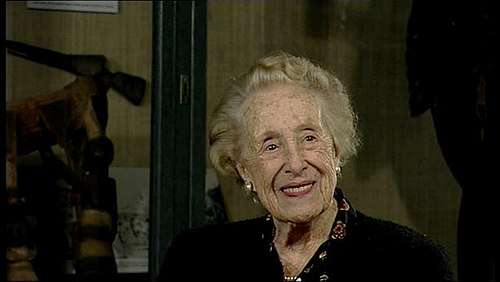Germaine Dieterlen
Germaine Dieterlen (15 May 1903 in Paris – 13 November 1999 in Paris) was a French anthropologist. She was a student of Marcel Mauss, worked with noted French anthropologist Marcel Griaule (1898-1956) and Jean Rouch, wrote on a large range of ethnographic topics and made pioneering contributions to the study of myths, initiations, techniques (particularly "descriptive ethnography"), graphic systems, objects, classifications, ritual and social structure.
She is most noted for her work among the Dogon and the Bambara of Mali, having lived with them for over twenty years, often in collaboration with Marcel Griaule, with whom she wrote an important book entitled The Pale Fox (1965). [1][2]

Themes
Some of the main themes in her work concentrate on the notions of sacred kingship, the position of the first born, relationships between maternal uncles and nephews, division of labor, marriage, and the status of the rainmaker in Dogon society. Because each episode of the rite is enacted only once every sixty years, Dieterlen's documentation of the Sigui cycle [3] was thought to allow the Dogon themselves to see and interpret the entire sequence of rites which they had heretofore only observed in part.
Research
Dieterlen began her ethnographic research in Bandiagara, Mali, in 1941. Perhaps most controversially, Dieterlen was criticized by her peers for her publications with Griaule on Dogon astronomy, which professed an ancient knowledge of the existence of a dwarf white star, Sirius B also called the Dog Star, invisible to the naked eye. This ancient indigenous knowledge (the Nommo) and the supposition that extraterrestrials might have been in contact with the Dogon was popularized by Robert K. G. Temple in his book The Sirius Mystery (1976) and Tom Robbins Half Asleep in Frog Pajamas (1995).
Dutch anthropologist W.E.A. van Beek, who spent seven years with the Dogon, seriously critiqued the research methods of Griaule and Dieterlen, suggesting, based on a conceived scenario presented by Brecher and Sagan, that they relied heavily on one primary informant who may have been influenced by the teachings of a Jesuit missionary who may have lived in the region prior to their arrival (Dogon Restudied 1991). He accuses Griaule of misinterpreting and influencing results.[4]. In addition, skeptic and space journalist, James Oberg in his investigation of the Dogon mystery, found no substantial evidence that would indicate outside influence, and sees such proposed scenarios as being "entirely circumstantial".[5]
Daughter and colleague of Marcel Griaule, Geneviève Calame-Griaule (see fr: Geneviève Calame-Griaule), defended her, dismissing van Beek's criticism as misguided speculation and being rooted in an apparent ignorance of esoteric tradition. [6]
Academic career
Dieterlen also served as a Director of Studies at Ecole Pratique des Hautes Etudes at the Sorbonne in Paris, a founding member of the Centre National de la Recherche Scientifique (CNRS), and a President of the Committee on Ethnographic Film (founded by Jean Rouch, with whom she worked and made important ethnographic films). An "hommage" collection published in 1978 (Systèmes de signes: Textes réunis en hommage à Germaine Dieterlen) included essays by Meyer Fortes and Claude Lévi-Strauss. Dieterlen also worked with other noted ethnographic filmmakers like Marcel Griaule. Mary Douglas reviewed the contributions made by Dieterlen to French anthropology in Dogon Culture - Profane and Arcane (1968) and If the Dogon . . . (1975). The Dogon gave Germaine Dieterlene the name of Madame l'Éternelle (The Eternal Lady) in memory of the work she made together with Marcel Griaule. [7]
See also
References
- The Amazing and Intriguing Dogons by Leon Dixon (June 19, 2010)
- Dogon Restudied - A Field Evaluation of the Work of Marcel Griaule Archived 2017-08-09 at the Wayback Machine by Walter E. A. van Beek
- Ancestral Initiation, article by Allen F. Roberts, University of California, Los Angeles
- Walter E. A. van Beek: "Dogon Restudied: A Field Evaluation of the Work of Marcel Griaule." Current Anthropology, 32 (1991): 139-167
- James Oberg, "Chapter 6, The Sirius Mystery", in UFOs and Outer Space Mysteries, (1982) Donning Press
- Geneviève Calame-Griaule: "On the Dogon Restudied." Current Anthropology, Vol. 32, No. 5 (Dec., 1991), pp. 575-577
- Philippe Costantini in his film Jean Rouch et Germaine Dieterlen - L'Avenir du souvenir
External links
- Obituary
- Germaine Dieterlen. Essai sur la religion Bambara (fr)
- On the Pale Fox, trail part 1 of 5 tracks of the Pale Fox in divination plots – film series about the Dogon myth of the Earth creation (extract)